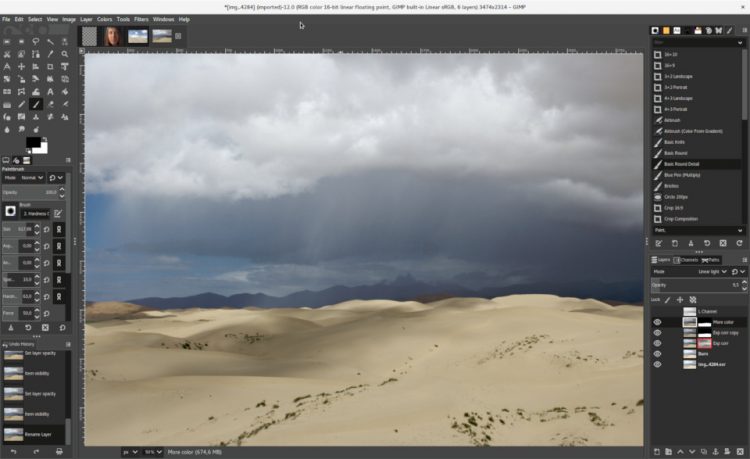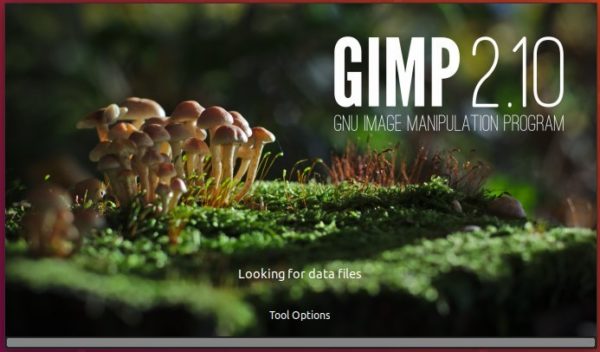It’s finally here: GIMP 2.10 is available to download for Windows, macOS and Linux.
The latest stable release of this insanely popular open source image editing tool – oft touted as a Photoshop alternative – has been 6 years in development.
Yes, six years.
Given the long gestation period you won’t be too shocked to hear that GIMP 2.10is jam-packed with changes, improvements and new features, both big and small, visible and non-visible.
To put things into perspective GIMP 2.8 was released back in 2012. Back then Unity was still fairly new, Netbooks were still (just about) a thing, Ubuntu Touch was looking healthy …and I was capable of churning out 8 posts a day, every day.
It’s now 2018. A far different landscape. Does GIMP still have what it takes to not only meet the demands of free software’s image editing enthusiasts, but retain its crown as go-to Photoshop alternative?
Let’s find out…
GIMP 2.10 Features

One thing is immediately noticeable about the new GIMP 2.10: its appearance. A new dark theme is enabled by default for new installs, and the toolbox makes use of cleaner symbolic icons.
‘One thing immediately noticeable about the new GIMP 2.10 is its appearance’
GIMP devs say these changes are designed to help improve concentration. The UI is effectively “dimmed” so that focus is placed on squarely on the content being worked on.
GIMP is not alone in doing this as many editing apps, both open source and proprietary, from Darktable and GNOME Photos to Photoshop, make use of ‘dark’ themes by default.
Among other features and changes new in this release:
- New dark theme & symbolic icon set by default
- Choice of 4 user interface themes
- Option to enable color toolbox icons
- Ability to adjust icon size
- Multi-threaded CPU support
- New blending modes
- Layer groups support masks
- New Unified Transform tool
- Nw Warp Transform tool
- New Handle Transform tool
- On-canvas Gradient editing
- Foreground Select tool supports sub pixel selections
- 80 GEGL-based filters (formerly ‘effects’)
- Split preview to compare original vs GEGL filter processing
- Improved crash recovery
- Ability to view/edit photo metadata
Photographers can take advantage of newGEGL-based photo filters in GIMP 2.10, including Shadows/Highlights and high-pass.
Additionally, it’s now possible to use Darktable or RawTherapee as plug-ins to open raw files in GIMP.
GIMP 2.10 also improves support for file formats including TIFF, PNG, PSD, FITS, and JPEG2000.
And of course, there’s a new splash screen to greet you each time you launch the app:
Experimental Tools
A number of experimental tools are included, but not enabled by default. You can turn these on (and off again, if you encounter issues) by launching GIMP 2.10 with the following flag:
gimp --show-playground
Then head toEdit > Preferences > Playground to enable the following tools:
- N-Point Deformation tool
- Seamless Clone tool
For a closer look at all of the changes see the GIMP 2.10 release notes or, for even more detail, review the change-log.
How to Install GIMP 2.10 in Ubuntu & Linux Mint
So that’s what’s new, but how can you try it?
GIMP 2.10 downloads for Windows, macOS and Linux (as source code) are available on the official GIMP website.
You can also install this update on Ubuntu 16.04 or later using one of the following methods.
Flatpak
The recommended way to install GIMP 2.10 on Linux is by using the official Flatpak app on the Flathub app store.
If you followed our list of things to do after installing Ubuntu 18.04 you should have Flatpak (and the Flathub repo) set-up already. If so, just search for GIMP in the Ubuntu Software app, find the Flatpak version, and install.
Alternatively, you can also run this command to install it from the repo directly:
flatpak install https://flathub.org/repo/appstream/org.gimp.GIMP.flatpakref
PPA
If you’re a fan of traditional package management then developer Otto Kesselgulasch’s GIMP PPA has you covered. His PPA has the latest version of the GNU Image Manipulation Program ready and waiting for Ubuntu 17.10 and above (16.04 builds are said to be on the way) users.
Although not official the PPA is maintained by a GIMP developer. As such I think this PPA is the best way to install GIMP 2.10 on Ubuntu, Linux Mint and other Ubuntu-based Linux distros.
And to do so open a new Terminal window and run these commands:
sudo add-apt-repository ppa:otto-kesselgulasch/gimp
sudo apt update && sudo apt install gimp
Snap
If you’re all about Snap apps then keep an eye out. An unofficial Snap of GIMP 2.10 will likely appear on the Snap Store in the coming weeks.
AppImage
AppImage fans will need to be patient. Build issues currently mean a GIMP appimage is not yet ready. Keep an eye on this Github page though.


